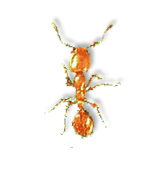
Image is not to scale.
 |
General Characteristics:
- Yellowish to light brown in colour
- Body length 1/32 inch (monomorphic)
- 10 segmented antennae with 2-segmented club
- They possess a stinger that is visible at the end of the abdomen
- Called 'thief ants' because they live in the nests of larger ant species and feed their own colony members with food stolen from the host species, including larvae and pupae
- Diet consists of meats, breads, sweets, nuts, animal fats, vegetable oil and dairy products. They may prefer high protein foods.
Reproduction:
- Nests contain several hundred to a few thousand individuals with numerous queens
- A single inseminated female can establish a nest independently and start a new colony on her own
- Queens lay between 27 and 387 eggs per day
- Workers developed from egg to adult in 52 days
- Nests in colonies if other species and steals food, larvae and pupae to feed their own colony
Signs of Infestation:
- Nests in exposed soil; under objects on the ground such as stones, logs, bricks, and inside decaying wood in stumps and in woodwork and masonry of homes
- Invade homes from outdoors, generally during hot weather, nesting in cracks and crevices and wall voids
- May be visible in homes foraging on set trails
- They can easily enter packaged food because their small size allows them to enter containers inaccessible to larger ants
Control Techniques:
- Inspections should be conducted to determine whether the ant is a thief ant or pharaoh ant, because control procedures for each vary greatly
- Baiting programs and insecticide treatments are both possible methods for control of this species
- A professional should be contacted to locate all nests and treat accordingly
Please click here to contact a Focus Pest Control professional to inquire about further treatments for this pest species.
References:
Benett, Gary W., et.al.. Truman’s Scientific Guide to Pest Control Operations. Duluth: Advanstar Communications, 1988.
Pp. 187.
Texas A&M University (Dept. of Entomology). “Thief Ant, Solenopsis molesta”(on-line). Accesses Aug 24, 2009 at http://urbanentomology.tamu.edu/ants/thief.cfm.
Disclaimer:
The Focus Pest Control ‘Pest Library’ is an educational resource written largely to educate the general public about common pests in Ontario. The Focus ‘Pest Library’ does not include all species in Ontario, nor does it include the most recent scientific data about species we describe. Though we edit our accounts for accuracy, we cannot guarantee all information in those accounts. While Focus Pest Control staff and contributors provide references to books and websites that we believe are reputable, we cannot necessarily endorse the contents of references beyond our control.
(Back to top)
|


